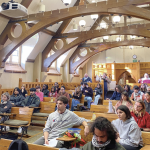Rajsi Rana ’26
Staff Writer
Trinity, like so many other schools, likes to display the “high value” it places on diversity. The website proudly states,“Trinity students are more than bold thinkers. They’re diverse doers,” yet Trinity’s campus is 60% white.
As someone who grew up in California, the most diverse state in the US, Trinity’s environment has been a big change. I value diversity in all forms, including gender identity, racial identity, and socioeconomic identity. I view being surrounded by a diverse group of people as something that teaches me about different ways of living. Though Trinity has a sizable population of international and out-of-state students, making up 85% of our student body, many of these students are from New England with very similar upbringings. Many grew up in an area of low diversity, with friends with backgrounds and experiences like theirs, meaning that they likely were not forced out of their comfort zone in terms of ways of thinking.
Trinity has a big lack of diversity in terms of socioeconomic status. Trinity has more students from the top 1%, with an income at or higher than $630,000, than the bottom 60%, with an income at or lower than $65,000. To be precise, Trinity has 26.2% students coming from the top 1%, while only 14.3% from the bottom 60%. All Trinity students are surrounded by wealth, which can manifest into several entitled students, leading to negative consequences on our entire student body in how we all interact with and perceive one another.
Trinity, as a private institution in New England, as a liberal arts school, and as part of the NESCAC group of colleges, does tend to attract a certain category of person. This lack of diversity is not only an issue at Trinity. The average liberal arts college has a 60% white student body. This is an issue colleges like Trinity should be seeking to fix. Along with providing their students with a better, well-rounded education, they will be supporting underrepresented students’ equal access to higher education. Trinity’s lack of diversity is having negative effects on many students on campus. With so many people from similar backgrounds, there are less people to stand up against discrimination in any form. Limited perspectives as a college leads to a less broadened mind upon graduation from Trinity, eventually hurting how alumni function and adapt to a more diverse world and workplace.
A big problem that stems from Trinity’s lack of diversity is the often tone-deaf words from peers. In participation-heavy courses, many discussions are often a disappointment with seemingly disengaged peers and limited viewpoints on a variety of relevant topics. This is not necessarily the fault of students, who are only a product of their environment. Trinity, however, has control over the environment they are placing their students in, and should be actively working to increase diversity on our campus. A diverse environment is a very shaping thing. In a more heterogeneous campus climate, there are different thoughts and opinions provided to the classroom, forcing people out of their comfort zone and into the more empathetic, understanding, and confident environment Trinity seeks to promote.


Thank you Rajsi. I believe most people would be in agreement with the benefits of diversity that you describe.
However, it would be helpful to clarify a couple of things.
First, you raise a question about Trinity and other schools being 60% white. I checked the latest census information and the nation is 57.8% white which is fairly close and possibly impressive given the demographics of the region upon which Trinity primarily draws its students. I even suspect that Trinity has moved faster to become more diverse in recent years than the nation has moved.
Second, you note that “This is an issue colleges like Trinity should be seeking to fix” and I am wondering if by “should” you are suggesting Trinity has not been trying to do everything possibly to address diversity. Tremendous investment of time and money has been made to get to the 60% figure and more importantly, to look beyond the statistic to make every effort to create a nurturing educational environment for all students.
Regarding economic diversity, I would welcome a conversation about the benefits of having students from wealthy backgrounds and the degree to which the responsibility of public and private colleges might differ in this regard. As an aid student, the wealth at Trinity was astounding to me. But I also figured it was a good thing to understand this segment of the student population as I thought I would probably end up working closely with them after graduation. So much of the focus is on negative aspects of wealth, but Trinity provided an environment where my exposure to them and hopefully their exposure to me and others like me could have some mutual benefits.
While there is still much progress to be made, I find what is missing in many of these conversations is the context of how far we have come and what the definition of ultimate success would be. The discussion would benefit more if, in this context, we reviewed what worked well, what didn’t work and what changes we’d like to see going forward. This would be the basis of a strategic plan that would have greater expectations of being more successful than past programs.
Similar to the poster ahead of me, I think Rajsi Rana has also overlooked how Trinity has changed in the past decades.
I also take issue with Rajsi Rana’s statement it is a “problem” that “The average liberal arts college has a 60% white student body.” Where’s the problem?
Is there a magic number of proportion that makes a campus suitably diverse? Must each affinity group be proportionally represented for diversity goals to be achieved?
Wikipedia tells us Connecticut is 63% to 66% white.
Looking to the pool of possible Trinity students, Wikipedia tells us “White non-Hispanics make up … 50% of the [U.S.] population between the ages of 18 and 24.”
So from the student-aged population, these liberal arts colleges referenced by Rajsi Rana are not exactly proportional in their representation of the national racial proportions. But is that really a problem? My understanding is Rajsi Rana considers this a problem. But I disagree. Where will the striving for diversity end?
Wikipedia tells us “82% of Connecticut residents age 5 and older spoke English at home.” How’s Trinity doing in this regard? Is this a problem? Wikipedia tells us 10% of Connecticut residents have English ancestry, whereas 26% of Americans do. 8.6% of Connecticut residents have German ancestry, whereas 17% of Americans do. How are the liberal arts colleges doing in this regard? Is it a problem?
To the author:
Is a room exclusively comprised of [insert racial minority group] diverse?
Does an individual’s socioeconomic status, race, ethnicity, gender, and sexuality pre-determine their viewpoint or way of thinking?
You mentioned that you value diversity in all forms, but does your sentiment extend to diversity of thought?
To everyone else:
I am deeply troubled by the immoral conduct of the Tripod, administration, and half-baked radical pseudo-intellectual members of the student body. Hopefully, my perception of Trinity is inaccurate, yet I can’t help but think that almost all of the adults have left the room.
At this point, it may be most appropriate to call Trinity College an illiberal arts school.
I would agree with other posters here. Rasjna is trying to compare Trinity to California as if California is representative of the country. This is a major flaw in the reporting.